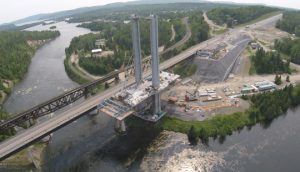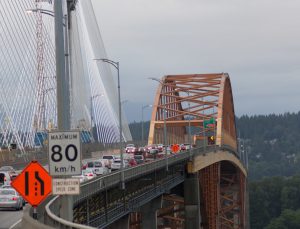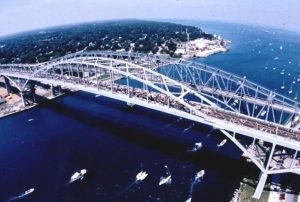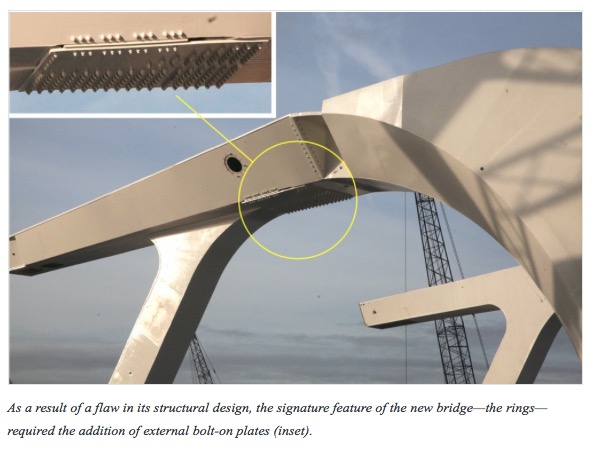This begins with the cable-stayed Nipigon River Bridge which failed six weeks after it opened (only half built). This bridge was budgeted at $106 million and in January of 2017, the Province of Ontario said that the repair work (permanent retrofit) will cost anywhere from $8 – $12 million.
In mid-April of this year, construction on the centre pier was halted after a concrete bridge deck fell while being hoisted from the ground to deck level. Does this mean more costs?
There is no information on costs in what had to be expensive testing and investigation into the components that failed, and the successive reports that were written to determine the cause.
Professional Engineers Ontario (PEO) has launched an investigation to determine whether or not there were acts of professional misconduct or incompetence by the engineers or engineering companies involved, but there has been nothing released to the public.
There has been NO determination from the Ontario Government who is responsible for the additional costs for the Nipigon River Bridge; or what the actual additional costs are.
Another recent bridge with huge uncontrolled costs is the new cable-stayed Vancouver Port Mann Bridge. Shockingly it has cost 10 times what it would have cost if the existing Arch Bridge had been twinned. In February 2009, it was announced that the BC government would foot the entire cost, $2.4 Billion, because the public-private partnership (P3) process had collapsed. Today, the tolls have been cancelled, further adding to the British Columbia taxpayer burden.
Cost of original Arch Bridge in 1964 was $25 million.
Cost of Cable Stayed Bridge in 2017 is $3 billion. (More recently reported to be $3.3 billion).
Inflation Factor: $100CDN in 1964 becomes $786CDN in 2017, or 8 times (= $200 million).
Add a generous safety factor of $100 million and cost of twinning is $300 million – not the reported $3 billion.
The engineer, Gerrit Hardenberg who designed and supervised the construction of the Port Mann Bridge questioned the decision to replace it.
The proposed Gordie Howe international Bridge, another cable-stayed bridge, is pegged to cost $4 billion plus – and these costs continues to rise; concerningly, all the properties needed have not yet been acquired!
The existing Ambassador Bridge was completed in 1929 for $23.5 million (1% under budget).
Inflation Factor: $100 in 1929 is $1387 in 2017 or approximately 14 times the 1929 number.
A first approximation of the cost of twinning the Ambassador bridge is 14 X 23.5 = $329 million, not the reported $4 billion++, which is more than 10 times the cost of twinning the Ambassador Bridge?
In all three cases (Nipigon, Port Mann, and Ambassador), the bridges could have been twinned with the existing bridge; taking advantage of a design that was proven, cut costs, and been far more attractive to the taxpayers’s pocket.
The fundamental problem appears to be political. It is the selection of a signature or iconic cable-stayed bridge. It costs at least 10 times that of a conventional bridge.
The solution (it is not too late) is to allow competing bridge designs for the proposed cable-stayed Gordie Howe Internatonal Bridge – as was done successfully with the beautiful twinning of the Blue Water Bridge in Sarnia/Port Huron – just a few miles upsteam.
- John Haight 32nd Annual Hockey Tournament - December 27, 2025
- Saturday Morning News – December 27 - December 27, 2025
- Winter Road Conditions & Weather – Saturday, December 27 - December 27, 2025
 Wawa-news.com You can't hear the 'big picture'!
Wawa-news.com You can't hear the 'big picture'!



The unnecessarily large expenditures of taxpayers money, to solve the current under-capacity in bridge crossings to the USA, are a black eye to every professional engineer practicing in Ontario and British Columbia. These very large wasteful expenditures already made in Nipigon, Ontario and Port Mann, British Columbia for cable stayed bridges, as opposed to the twinning of truss structures must not proceed for the the Gordie Howe crossing in Windsor.
Has the quest for profit from a Cable Stayed structure with a pretty face, replaced sound engineering principles of doing for one dollar what any damned fool can do for two?
Dave Adams, elected Past President of the Professional Engineers of Ontario ( three time )
Morouns get Canadian permit for second Ambassador Bridge span, say they’ll build soon.
“Oh what a tangled web we weave…..”
The Moroun statement gave the following details:
• The new bridge would be six lanes wide, three in each direction with dedicated NEXUS, FAST and bus lanes.
• It would measure 2,190 feet and be a so-called cable-stayed type, in which the cables supporting the traffic deck fan out from a supporting tower.
• There would be new and expanded commercial inspection facilities, including additional commercial inspection booths, to clear customs.
• The cost would be about $1 billion in private funds, about half of which has already been spent.
Here is the story from the Detroit Free Press:
http://www.freep.com/story/money/2017/09/06/moroun-canada-bridge-windsor-detroit/639069001/
What is this statement really saying?
1. It will be a Cable-Stayed Bridge – no competition from conventional bridge designs.
2. It is estimated to cost $1 billion of which half has already been spent. Half ($500 million) has already been spent on what?
3. The Gordie Howe Bridge now takes second place to the Morounn Bridge? Is Canada really saying “we are throwing in the towel and the Gordie Howe will never be built.” ???
4. Will the multi-million dollar Herb Gray Expressway leading to the Gordie Howe be a Highway to Nowhere?
5. If the Moroun Family can build it for $1 billion, why is it costing $4 billion ++ for Canada to build one 2 miles to the south.
6.Who pays when it costs more than $1. billion? The devil is in the details
This whole thing is deceptive and deceitful.
I’m a little bit curious as to why they are going to such expense to build another bridge?
a) is the original Ambassador Bridge in poor condition?
b) will the Gordie Howe Bridge actually be built, remembering the P3 process failed in the Port Mann Bridge and they had to go with full public funding..
c) If there is a public outcry, can they stop the Gordie Howe easier than if there would not be a second Ambassador?
d) the Gordie Howe will also be a toll bridge to compete?
e) If the design, bid and building process for the Gordie Howe is delayed – that continues to put money in the Mahoun family pockets with or without the building of a second Ambassador Bridge and this being a private bridge they can charge as little or as much as they desire.
The original Ambassador Bridge is 4 lane. Toll is $5USD – Commercial is an average of $5USD an axle (so using 5 axles per transport).
Estimates are 8,000 trucks and 68,000 travelers daily. $200,000 (est. 5 axles each truck) + 340,000 for cars = an estimated $540,000 daily!
By adding two more lanes with the new Ambassador Bridge, they could add another $270,000 daily, resulting in an estimated $98,550,000 (~ $100 million) yearly in gross revenue? and they can pay their new $1 billion bridge off fast!
f) How can a private company build a bridge for $1 billion when they are estimating $4 billion plus for the Gordie Howe.
g) how would Mr. Howe have felt about his name associated with this?
Today:
CBC investigates Cable-Stayed Port Mann Bridge.
Public Inquiry called for.
http://www.cbc.ca/news/canada/british-columbia/inside-cbc-s-port-mann-bridge-investigation-1.4267767
The Grenfell Tower Inferno; The Cable-Stayed Gordie Howe International Bridge (now 2 Bridges); and The Common Thread.
It is hard to imagine anyone approving the ALCOA flammable panels (now called “fire panels”) for the Grenfell Tower in London, England, and in other countries, but it happened, and in one case in Dubai the Skyscraper went on fire TWICE! No Building Code in the world would allow these panels in this situation.
It is also hard to imagine anyone approving “exclusively” a Cable-Stayed Bridge in Canada after the experience of the Port Mann Cable-Stayed Bridge in Vancouver and the Nipigon River Cable-Stayed Bridge in Northern Ontario (the so-called “Jewel of the North”).
What is the common thread?
Grenfell Tower Inferno: First reaction: Who was the Architect playing God here? BUT,
From the London Guardian: June 27, 2017: “Architects like me know Grenfell Tower fire was an avoidable tragedy”. Deon Lombard, Architect.
“It was not an act of God, but the tragic outcome of a growing void in the responsibility, expertise and single oversight of large construction projects.…. Bring back the specification of materials to a single point of responsibility under the architect or engineer responsible…. Allow the experts to do what they do best without interference from politicians or those who tend to take shortcuts….”
The Gordie Howe International Bridge:
From the Windsor Star, March 2, 2017: (From a press release by Windsor-Detroit Bridge Authority (WDBA)): Gordie Howe International Bridge Recognized With Prestigious Award.
Who is CG/LA that presented this award? It is a firm dedicated to building global competitiveness and opportunity through infrastructure project creation. They do this for businesses, private investors….. It does not represent the citizens of Canada but it partners with firms like Kiewit, SNC, and other multinationals who build infrastructure. Accolades for this CG/LA award were given by Canada’s Minister of Infrastructure and Communities, Michigan Governor Rick Snyder, and Dwight Duncan, Chair, WDBA Board of Directors.
This is not an award but a promotion of the most expensive, least practical bridge ever conceived for this purpose and it’s 10 times the cost of a conventional bridge to do the same job.
Sir Sanford Fleming and Sir Casimir Gzowski would be appalled. Canadians would be too if they knew what was going on.
I have no doubt that you are correct in stating that the cost of cable-stayed bridges is very much higher than conventional (truss or arch) bridges of the same size. I do doubt that the multiple is 10. I think using that multiple impairs the credibility of your argument (sounds a little like fake news), when you only know the real cost of one of them.
If you are using actual costs of an actual constructed bridge and comparing that to the factoring up by inflation the cost of a bridge built decades ago, I think that approach lacks credibility.
Can you not find some place where the two types were designed, bid, and then one was chosen?
To your question Anonymous: “Can you not find some place where the two types were
designed and bid and then one was chosen?”
Answer: Yes. The Blue Water Bridge in Sarnia.
The Cable-Stayed Bridge was rejected because the people of Sarnia felt it
clashed in appearance with their beloved Modjeski* beautifully designed
Bridge. The people were right for the wrong reason.
Blue Water Bridges:
Original: 1938 was $4 million.
New: 1995 was $41.3 million
Say 10 times.
Inflation:
$100 in 1938 is $1058 in 1995.
Say 10 times.
That refutes your theory of a non-linear cost increase.
By the same logic.
Ambassador Bridge:
1929 was $23.5 million.
Inflation: $100 in 1929 is $1387 in 2017 Say 14 times.
Therefore, the new Ambassador Bridge should be 14 x 23.5 = $329 million, not
$4 billion++. And that’s before the change orders!
Google:
* Rudolf Modjeski, Polish American Structural Engineer in competition with
Joseph Strauss, designer of the Golden Gate Bridge. We were Bridge Stars in those days.
I have done a cost analysis on not one, but four of them.
1. The Baxter International Theme Building, which I designed in Chicago in 1974, caused the Baxter VP of Engineering to be fired, and, ironically, I was named to the partnership of SOM – the top Architectural firm in the world at that time – and possibly still.
2. The Nipigon River Bridge in Northern Ontario, which failed dramatically just 6 weeks after the first half opened is still under construction. It cut Canada’s transportation system in half. Trucks were driving around the US side of Lake Superior to get to Winnipeg. I have done extensive studies on this which got me publicly rebuked by the Registrar/CEO of Professional Engineers Ontario, Gerard McDonald.
3. The Port Mann Bridge in Vancouver: This is about to become the subject of a Judicial Investigation. The inflation factored price is $300 million and the latest actual cost is $3.3 billion.
4. The Gordie Howe: This is already far more than 10 times the cost of the Ambassador Bridge factored for inflation.The inflation factored price is $329 million and the last price tag is $4 billion + +.
There is a place where different types of bridges were proposed in year 2000 but none yet selected: The Peace Bridge in Fort Erie is a case where 5 types were proposed by different Engineering Firms. Roger Dorton, Order of Canada, was chair of the Bi-National Committee to select the winner. His committee chose a twin. This was year 2000 – the year Roger quit all involvement in Engineering. Buffalo and New York State over-ruled his committee.
The Bi-National Committee recommended Twinning but opposition headed by NY Senator Daniel Patrick Moynahan wanted a “Signature” bridge. Seventeen years have passed and nothing has been built and lineups are huge.
A note from David Adams, Three Times Elected President of Professional Engineers Ontario – followed by my response:
Dear Michael,
I am delighted that you have published these sound opinions on the Canadian Bridge Building saga that has produced seemingly more costly failures in the last number of years than successes, and is poised to continue this record at taxpayer expense.
Regretfully I am forced to speak out against this current record of approval of bridge design and construction, now revealed by yourself as a bridge designer even though the current Minister of Transportation in Ottawa is headed by a MCGILL UNIVERSITY graduate engineer, from my own Alma Mater.
Dave Adams, P. Eng., MBA, three times elected by the members as president of Professional Engineers
Ontario.
THANK YOU, DAVE!
You are speaking about Marc Garneau, one of the greatest achievers in Our Profession. Marc is more that a great engineer-astronaut. He is a great Canadian Humanitarian and Honorary Chairman of Hope Air, a Canadian Charity dedicated to flying those in need to medical care. I’ve been flying for them for the past 18 years.
Marc: If you are listening, please correct the mistake (not your fault) of making these bridges “exclusively cabled-stayed”. Open the tender process to competition as was done with the bridges at Ft. Erie – Buffalo and Sarnia – Pt. Huron. Put these lobbyists from the Washington Swamp out of business and save Canadian taxpayers a few billion dollars.
Michael Hogan, P. Eng., PhD, Volunteer Pilot, Hope Air.
How do we get these cable-stayed bridges outlawed as an insult to the taxpayer?
How do we hold the politicians who choose them to account?
Roger Jones, PEng, MBA, SMIEEE, FEC
The 1995 cost of the Sarnia/Port Huron 2nd Bluewater Bridge (from Michigan Department of Transport) is:
Bridge: $41.3 million
Plaza: 55.0
Rehab: 21.3
———————-
Total: $117.6 million which is 1/2 the total in 1996 as Canada and USA were each paying half.
Inflation Factor $100 in 1996 is $149 in 2017. (Say 1.5 times).
Therefore, the First Estimate for The Gordie Howe is:
117.6 X 2 X 1.5 = $352.8 million
The previous approach, based on the cost of the Ambassador Bridge in 1929 of $23.5 million multiplied by the Inflation Factor of 14 gave a First Estimate of The Gordie Howe of $329 million.
Summary: First Approximation of the Gordie Howe is: $329 to $353 million.
Question: How has the present estimate reached more than $4 billion?
Note: $4,000 million/$353 million = 11.3 times a conventional bridge?
Why is a Cable-Stayed Bridge 10 Times The Cost of a Conventional Bridge?
A picture is worth a thousand words. Below are pictured the 5 bids for the Peace Bridge replacement/twin (Ft. Erie/Buffalo) in year 2000.
Roger Dorton, P. Eng., Order of Canada, was the spokesperson for the Bi-National (Canada/USA) Committee. He proposed #1.
Daniel Patrick Moynahan, Senator for New York State, led the call for a ‘Signature Bridge’. Today, 2017, nothing has been done. Buffalo is not a wealthy city.
Isn’t it obvious?
The new Victoria, British Columbia Bascule Bridge has failed structurally and it hasn’t opened yet.
Whatever became of Structural Engineers? Joseph Strauss was the structural engineer-designer of this original Johnson Street Bridge, in Victoria. 87 years later it is still working fine – with only 2 -75 hp motors!
He went on to design the Golden Gate Bridge in San Francisco.
Watch this video of the winning Architect dissing his design: https://m.youtube.com/watch?v=QM905z_oM0M
How many hp does it take to lift this Architectural Masterpiece? 8 X the original? When it works, the Architect is a hero. When it doesn’t, it’s the fault of the foolish Engineers who tried to make a silk purse out of a sow’s ear.
How did Architects usurp the role of Structural Engineers in bridge design? Easily: Sell the sizzle and pretend it’s steak.
This bridge is now ~C$115 million. Costs were initially estimated at C$63 million. The original in 1924 was C$0.918. From Bank of Canada Inflation calculator: $1 in 1924 is $14.4 in 2017. That is ~C14 million for this bridge today. Reasonable.
How did it get to be 8 times its inflation-adjusted cost – with defective main structural members?
Here is the answer: http://www.focusonvictoria.ca/janfeb2018/bridge-design-flaw-hidden-for-a-year-then-given-quick-and-dirty-repair-r15/
And here is the original ‘Canada’s Next Bottomless Money Pit’:
https://wawa-news.com/index.php/2017/09/01/canadas-next-bottomless-money-pit-the-cable-stayed-gordie-howe-international-bridge/
The latest Architectural Movement is called “Post Structural”, coined by the world renowned Canadian Architect Frank Gehry (Art Gallery of Ontario, etc.). This bridge is definitely Post Structural.
Post Structural Arcbitecture – Google Search: What is it?
Canadian-American Architect Frank Gehry (Art Gallery of Ontario) is recognized as the leading light in this new area of Architecture.
https://www.google.ca/search?q=Post+Structural+Arcbitecture&ie=UTF-8&oe=UTF-8&hl=en-ca&client=safari
Here are a few Post Structural Architectural Masterpieces to add:
1. Florida International University’s signature pedestrian bridge with a cable-stay facade collapsed killing six and injuring nine. There have been concerns made about a design change that put the project behind schedule and nearly $3 million over budget; and that it may have been a possible factor in the collapse.
2. Nipigon River Cable-Stayed Trans-Canada Highway Bridge which has failed six weeks after opening. Budgeted at $100 million but experience shows it will be $200 million before completion.
3. Victoria BC Johnson St. Bascule Bridge which has a number of serious concerns during construction including a structural failure that required redesign.

There were significant delays in construction because of test results showing the steel and fabrication to be sub-par (July 2014), these fabrication problems delay construction again in June 2017. It replaced the 1924 Bascule Bridge designed by Golden Gate Structural Engineer Joseph Strauss (94 years in service). The bridge finally opened after 10 years of construction. https://www.vicnews.com/news/johnson-street-bridge-getting-a-troubled-project-back-on-the-rails/
4. The Gordie Howe International Cable-Stayed Bridge which was budgeted at $2 billion but has now been estimated at over $4 billion but all the lands now yet been acquired. It is being promoted by the Washington Lobby Group CGLA.